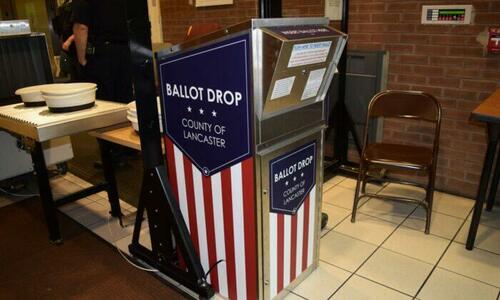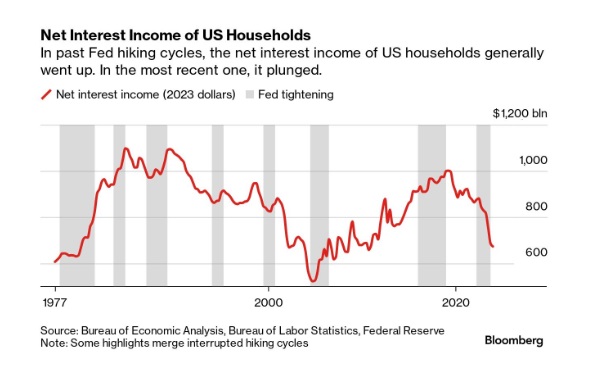Spread & Containment
Pennsylvania County Bans Ballot Drop Boxes
Pennsylvania County Bans Ballot Drop Boxes
Authored by Beth Brelje via The Epoch Times (emphasis ours),
A standing room-only crowd made up…

Authored by Beth Brelje via The Epoch Times (emphasis ours),
A standing room-only crowd made up mostly of organized, left-leaning, political activists shouted, “Shame! Shame!” when commissioners in Pennsylvania’s Lancaster County voted to remove a ballot drop box placed at the county building on Monday, the day before the primary election.
Now, instead of placing absentee ballots in the drop box located just three steps inside the door of the county building, voters will have to walk about 30 steps into the building, from the same door, to get to the Board of Elections office where they will hand their ballot directly to one of the workers.
Anyone entering the building beyond the drop box must go through a metal detector manned by the sheriff department. Opponents say this makes voting “too difficult and complex” for voters.
At the time of the commissioners’ vote on Monday, the county’s lone drop box had only been in place since Friday.
Around the nation, the use of unmanned drop boxes has met with scrutiny amid evidence of suspected fraud. The Dinesh D’Souza film “2000 Mules” features government surveillance footage showing people stuffing drop boxes with multiple ballots in multiple locations in numerous states.
Another investigation by Pennsylvania’s Lehigh County District Attorney’s Office, in which detectives reviewed hours of video of the county’s drop boxes for the October 2021 elections, found hundreds of people putting multiple ballots into unmanned drop boxes.
Pennsylvania law requires a voter to send an absentee ballot by mail or deliver it personally. Yet, Gov. Tom Wolf’s wife, Frances Wolf, broke this law in the October 2021 election, when she deposited her own ballot along with her husband’s ballot in a York County ballot drop box. The governor later called it an honest mistake.
Lancaster County had not intended to provide a drop box for the primary election, but the county was sued last week by the American Civil Liberties Union, claiming that it had failed to meet in the sunshine to decide not to use drop boxes.
But a judge ruled on May 13 that the decision not to used drop boxes was administrative and did not need to be discussed in a public meeting, Lancaster County Commissioner Ray D’Agostino told The Epoch Times. The judge ordered the county to return to status quo, which he considered to be with drop boxes. He also allowed for the commissioners to meet on Monday and vote on the use of ballot boxes in the county.

With one commissioner out of town, two of the three commissioners met at 11 a.m. on May 16 and passed a resolution banning ballot drop boxes from being used in Lancaster County for this primary or any future election, unless compelled by Pennsylvania statute or by an official legal authority.
Before the vote, commissioners took about an hour of public comment.
In a group email, Duncan Hopkins, an organizer with the advocacy group Lancaster Stands Up, rallied Democrats to attend the meeting. In the email, he alleged that commissioners “are working so hard to confuse voters and make it more difficult for many to cast a ballot so close to an election.”
Representatives from the NAACP, League of Women Voters, Lancaster Democratic Party, Lancaster City Democrats, Pennsylvania CASA, and Lancaster Stands Up implored the commissioners to expand drop boxes to every community in the county instead of removing the county’s only drop box.
“It is a sense of privilege to say everyone can get here to vote,” said one woman, whose mother is 96 and uses oxygen.
Often, activists would snap fingers in unison or murmur support when one of their group spoke.
“I don’t understand why you want to make it harder to vote,” another person told the commissioners.
LaRock Hudson, political action chair for the local NAACP, challenged commissioners to provide data proving that drop boxes cause voter fraud, as preventing possible fraud was a reason mentioned in the resolution for banning drop boxes.
The introduction of drop boxes was a decision made in response to the COVID-19 pandemic. Lancaster County used a drop box in 2020 and 2021 for COVID-19 mitigation. The drop box was placed near sheriffs handling security for the building, they had an election person watching the box at all times, and it was surveilled by camera.
“Things have changed, COVID is no longer such an issue, we are short staffed,” D’Agostino said. “We can’t have sheriffs doing a job of election staff, and election staff have better things to do than sitting at a box when people aren’t there. They could be sitting at their desk and as people come in, take the ballot. But when they’re not taking ballots, they can be doing other work, so there’s no need, quite frankly, to have that box there anymore.”
Several people spoke in favor of removing the drop box.
Kirk Radanovic, chairman of the Lancaster County Republican Club, said he was representing the 176,000 Republicans of Lancaster County who expect the commissioners to remove the ballot drop boxes to keep election integrity safe.
Another speaker said our parents and forefathers managed to get to the polls to vote, even when they worked or lived far away from the polls, and they expected to get election results on election day. She reminded attendees that verified absentee ballots have always been available for those who are too sick to get to the polls.
Dan Medbury, a Lancaster County resident and member of the John Birch Society, said the difficulty of voting is not in getting to the polls, but investing the time as a voter to research the positions of candidates.
“Too many people want extreme ease when they don’t take time to study the issues,” Medbury said.
After the resolution was passed, the ballot drop box was removed from the front door. The nearby election office will remain open until 8 p.m. until election day to receive any hand delivered ballots.
Spread & Containment
Household Net Interest Income Falls As Rates Spike
A Bloomberg article from this morning offered an excellent array of charts detailing the shifts in interest payment flows amid rising rates. The historical…

A Bloomberg article from this morning offered an excellent array of charts detailing the shifts in interest payment flows amid rising rates. The historical anomaly was both surprising and contradicted our priors.
10 Key Points:
- Historical Anomaly: This is the first time in the last fifty years that a Federal Reserve rate hike cycle has led to a significant drop in household net interest income.
- Interest Expense Increase: Since the Fed began raising rates in March 2022, Americans’ annual interest expenses on debts like mortgages and credit cards have surged by nearly $420 billion.
- Interest Income Lag: The increase in interest income during the same period was only about $280 billion, resulting in a net decline in household interest income, a departure from past trends.
- Consumer Debt Influence: The recent rate hikes impacted household finances more because of a higher proportion of consumer credit, which adjusts more quickly to rate changes, increasing interest costs.
- Banks and Savers: Banks have been slow to pass on higher interest rates to depositors, and the prolonged period of low rates before 2022 may have discouraged savers from actively seeking better returns.
- Shift in Wealth: There’s been a shift from interest-bearing assets to stocks, with dividends surpassing interest payments as a source of unearned income during the pandemic.
- Distributional Discrepancy: Higher interest rates benefit wealthier individuals who own interest-earning assets, whereas lower-income earners face the brunt of increased debt servicing costs, exacerbating economic inequality.
- Job Market Impact: Typically, Fed rate hikes affect households through the job market, as businesses cut costs, potentially leading to layoffs or wage suppression, though this hasn’t occurred yet in the current cycle.
- Economic Impact: The distribution of interest income and debt servicing means that rate increases transfer money from those more likely to spend (and thus stimulate the economy) to those less likely to increase consumption, potentially dampening economic activity.
- No Immediate Relief: Expectations for the Fed to reduce rates have diminished, indicating that high-interest expenses for households may persist.



Spread & Containment
TJ Maxx and Marshalls follow Costco and Target on upcoming closures
Many of these stores have information customers need to know.

U.S. consumers have come to increasingly rely on the near ubiquity of convenience stores and big-box retailers.
Many of us depend on these stores being open practically all day, every day, even during some of the biggest holidays. After all, Black Friday beckons retail stores to open just hours after a Thanksgiving Day dinner in hopes of attracting huge crowds of shoppers in search of early holiday sales.
Related: Walmart announces more store closures for 2024
And it's largely true that before the covid pandemic most of our favorite stores were open all the time. Practically nothing — from inclement weather to bad news to holidays — could shut down a major operation like Walmart (WMT) or Target (TGT) .
Then the pandemic hit, and it turned everything we thought we knew about retail operations upside down.
Everything from grocery stores to shopping malls shut down in an effort to contain potential spread. And when they finally reopened to the public, different stores took different precautionary measures. Some monitored how many shoppers were inside at once, while others implemented foot-traffic rules dictating where one could enter and exit an aisle. And almost every one of them mandated wearing masks at one point or another.
Though these safety measures seem like a distant memory, one relic from the early 2020s remains firmly a part of our new American retail life.
Store closures announced for spring 2024
Many retailers have learned to adapt after a volatile start to this third decade, and in many ways this requires serving customers better and treating employees better to retain a workforce.
In some cases, the changes also reflect a change in shopping behavior, as more customers order online and leave more breathing room for brick-and-mortar operations. This also means more time for employees.
Thanks to this, big retailers have recently changed how they operate, especially during holiday hours, with Walmart recently saying it would close during Thanksgiving to give employees more time to spend with loved ones.
"I am delighted to share that once again, we'll be closing our doors for Thanksgiving this year," Walmart U.S. CEO John Furner told associates in a video posted to Twitter in November. "Thanksgiving is such a special day during a very busy season. We want you to spend that day at home with family and loved ones."
Other retailers have now followed suit, with Costco (COST) , Aldi, and Target all saying they would close their doors for 24 hours on Easter Sunday, March 31.
Now, the stores that operate under TJX Cos. (TJX) will also shut down during the holiday, including HomeGoods, TJ Maxx and Marshalls.
Though it closed on Thanksgiving, Walmart says it will remain open for shoppers on Easter.
Here's a list of stores that are closing for Easter 2024:
- Target
- Costco
- Aldi
- TJ Maxx
- Marshalls
- HomeGoods
- Publix
- Macy's
- Best Buy
- Apple
- ACE Hardware
Others are expected to remain open, including:
- Walmart
- Ikea
- Petco
- Home Depot
Most of the stores closing on Sunday will reopen for regular business hours on Monday.
spread pandemicInternational
Gates-backed PhIII study tuberculosis vaccine study gets underway
A large study of an experimental vaccine for the world’s biggest infectious disease has finally kicked off in South Africa.
The Bill & Melinda Gates…

A large study of an experimental vaccine for the world’s biggest infectious disease has finally kicked off in South Africa.
The Bill & Melinda Gates Medical Research Institute (MRI) will test a tuberculosis vaccine’s ability to prevent latent infections from causing potentially deadly lung disease. Last summer the nonprofit said it would foot $400 million of the estimated $550 million cost of running the 20,000-person Phase III trial.
It’s a pivotal moment for a vaccine whose origins date back 25 years when scientists identified two proteins that triggered strong immunity to the bacterium that causes tuberculosis. A fusion of those proteins, paired with the tree bark-derived adjuvant that helps power GSK’s shingles shot, comprise the so-called M72 vaccine.
After decades of failures in the field, the vaccine impressed scientists in 2018 when GSK found that it was 54% efficacious at preventing lung disease in a 3,600-person Phase IIb study.
But the Big Pharma decided that a full-blown trial was too expensive to conduct on its own. Gates MRI stepped in to license the vaccine in early 2020, right before the Covid pandemic shifted global vaccine priorities towards the coronavirus, further stalling the tuberculosis shot.
“There’s been frustration that it’s taken so long to get this trial up and running,” Thomas Scriba, deputy director of immunology for the South African Tuberculosis Vaccine Initiative, told Endpoints News last summer.
At last, the vaccine is getting a chance to prove itself in a bigger study. If successful, it could lead to the first new shot for tuberculosis in over a century.
Emilio Emini, CEO of the Gates MRI, told Endpoints that the initial results may come in roughly four to six years. “Hopefully this will galvanize a refocus on TB,” he said. “It’s been ignored for many, many years. We can’t ignore it anymore.”
A substantial impact
Even though an existing vaccine helps protect babies and children against severe tuberculosis, the bacterium responsible for the disease still causes roughly 10 million new cases and 500,000 deaths each year.
 Emilio Emini
Emilio EminiBy vaccinating adolescents and adults who test positive for infections but don’t have symptoms of lung disease, the Gates MRI hopes the shot will help prevent mild infections from becoming severe ones, curtail transmission of the bug, which is predominantly driven by people with lung disease, and reduce deaths.
“The impact would be substantial,” Emini said. But he cautioned that the biology behind mild and severe diseases is still mysterious. “The reality is that no one really knows what keeps it under control.”
The study, which will take place at 60 sites across seven countries, will include some people who are not infected with tuberculosis to ensure that the vaccine is safe in that broader population.
“Having to pre-test everybody is not going to make the vaccine easy to deliver,” Emini said. If the vaccine is ultimately approved, it will likely be used in targeted communities with high tuberculosis, rather than across a whole country, he added. “In practice, you would immunize everybody in those populations.”
Emini described the Gates MRI’s rights to the vaccine as “close to a worldwide license.” GSK retained rights to commercialize the vaccine in certain countries but declined to specify which ones.
A spokesperson for GSK said that the company “has around 30 assets under development specifically for global health … none of which are expected to generate significant return on investment.”
“It is not sustainable or practical in the longer term for GSK to deliver all of these alone. So we continue to work on M72, but in partnership with others,” the spokesperson added.
If the shot works, Emini said that the Gates MRI will sublicense it to a manufacturer that will be responsible for making and marketing the vaccine. The details are still being worked out, he noted.
vaccine pandemic coronavirus deaths new cases transmission africa-

 Spread & Containment6 days ago
Spread & Containment6 days agoIFM’s Hat Trick and Reflections On Option-To-Buy M&A
-

 Uncategorized4 weeks ago
Uncategorized4 weeks agoAll Of The Elements Are In Place For An Economic Crisis Of Staggering Proportions
-

 International2 weeks ago
International2 weeks agoEyePoint poaches medical chief from Apellis; Sandoz CFO, longtime BioNTech exec to retire
-

 Uncategorized1 month ago
Uncategorized1 month agoCalifornia Counties Could Be Forced To Pay $300 Million To Cover COVID-Era Program
-

 Uncategorized4 weeks ago
Uncategorized4 weeks agoApparel Retailer Express Moving Toward Bankruptcy
-

 Uncategorized1 month ago
Uncategorized1 month agoIndustrial Production Decreased 0.1% in January
-

 International2 weeks ago
International2 weeks agoWalmart launches clever answer to Target’s new membership program
-

 Uncategorized1 month ago
Uncategorized1 month agoRFK Jr: The Wuhan Cover-Up & The Rise Of The Biowarfare-Industrial Complex





















